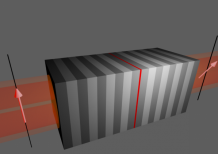Reviewed by Alex SmithJun 21 2022
In their drive to manipulate light to develop the next generation of quantum sensing and computing, scientists have made a significant new achievement.
 This is a pivotal breakthrough in the quest to control light to evolve the next generation of quantum sensing and computing. Image Credit: University of Exeter.
This is a pivotal breakthrough in the quest to control light to evolve the next generation of quantum sensing and computing. Image Credit: University of Exeter.
Controlling light may be performed by creating and monitoring a nonlinear phase shift down to a single polariton level, according to a team of researchers led by Dr. Oleksandr Kyriienko of the University of Exeter.
Polaritons are hybrid particles that mix light and matter characteristics. They form when photons hybridize with underlying particles in materials — quantum well excitons — in optical systems with significant light-matter connection (bound electron-hole pairs).
The latest study, conducted by Prof D Krizhanovskii’s experimental group at the University of Sheffield, discovered that an interaction between polaritons in micropillars causes cross-phase modulation across modes of differing polarization.
Even in the presence of (on average) a single polariton, the phase shift is considerable, and it may be amplified in systems with stronger light confinement. This opens the door to quantum polaritonic phenomena, which might be employed in quantum sensing and computation.
Dr. Oleksandr Kyriienko’s theoretical study demonstrates that the observed single polariton phase shift may be amplified further, and that cascading micropillar can lead to polaritonic quantum gates.
Quantum effects with weak light beams can aid in the detection of chemicals, gas leaks, and computing at a much faster rate.
Nature Photonics reported the findings.
The experimental results reveal that quantum effects at single polariton level can be measured in a single micropillar. From the theory point of view, it is important to increase phase shifts and develop the system into an optical controlled phase gate. We will definitely see more efforts to build quantum polaritonic lattices as a quantum technology platform.
Dr. Oleksandr Kyriienko, Department of Physics and Astronomy, University of Exeter
Polaritons have shown to be an effective substrate for nonlinear optics, with higher coherence thanks to the cavity field and significant nonlinearity from exciton-exciton scattering.
Polaritonic experiments have previously shown polaritonic Bose–Einstein condensation and a variety of macroscopic nonlinear phenomena, such as solitons and vortices. The detection of quantum polaritonic effects at the low occupancy limit, on the other hand, remains unknown territory.
In extremely tiny occupations, polaritons can maintain nonlinearity and coherence, according to the research. This prompts a quest for polaritonic systems capable of enhancing quantum effects and acting as quantum devices.
We have used high quality micropillars from gallium arsenide provided by collaborators from University of Paris Saclay, France. These pillars confine modes of different polarization that are close in energy. By pumping light into one of the modes (fundamental), we probe a signal sent into another (higher energy) mode, and observe that the presence of weak (single photon) pulse leads to polarization rotation. This can be seen as a controlled phase rotation.
Dr. Paul Walker, Study Corresponding Author, Department of Physics and Astronomy, University of Sheffield
“In the presented experiment we have made a first step to see single-polariton effects. There is certainly a room for improvement. In fact, using cavities of smaller size and optimizing the structure we expect to increase phase shift orders of magnitude. This will establish the state-of-the-art for future polaritonic chips,” the senior author of the study, Prof Krizhanovskii, concludes.
Journal Reference:
Kuriakose, T., et al. (2022) Few-photon all-optical phase rotation in a quantum-well micropillar cavity. Nature Photonics. doi.org/10.1038/s41566-022-01019-6.